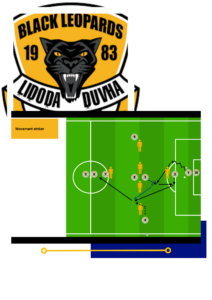Football with Purpose: Training to Play, Not Just to Repeat
As we’ve discussed before, this section will cover football training drills that I’ve used with the teams I’ve coached, providing context and exploring the reasoning and objectives behind them. We’ll continue with drills and some football insights.
If you’re interested in how these drills were developed and the ideas that shaped this coaching approach, click here.

Context
We are in the 2023/2024 season at Black Leopards FC in South Africa, working with a group of young and talented players. 75% had never played professionally, and 50% were under 22 years old.
Among the 9 players occupying winger and forward positions, 7 were under 21 years old, and all had the ability to repeat high-intensity efforts, with many also possessing great speed. In midfield, we had players capable of delivering through balls between lines and driving forward with agility.
We were looking for players with mobility to make repeated runs behind defenders (receiving long balls) and creating imbalances in the final third (receiving in interior spaces). If they received inside, we prioritized turning, driving forward, and making the best possible decision based on the game situation. This was to be our first key principle.
With this decision made, we began designing our first exercises. One of them was a warm-up (or post-warm-up) drill with the ball, which we will describe below.
It is important to highlight that this exercise was used to prepare players for the main part of the session, focusing on aggressive movements and speed. It was always used as a post-warm-up task, a specific drill with the fitness coach, or a technical warm-up with the ball.
In the next article, we will discuss a positional possession drill, which in many cases, we used as a follow-up to this exercise.
Pass Circuit with Offensive Line Movements
As mentioned in the previous article, we wanted to work with the forwards on a movement that would allow them to receive with more time and space, executing an action contrary to the defender’s reaction.
There’s a phrase I often repeat:
“The ball attracts simply because it is the ball. It’s like a piece of candy in the middle of a group of kids.”
The defender is that child, moving instinctively toward the ball. Defenders tend to follow vertical movements toward the ball, which forces offensive players to make diagonal movements, moving away from their trajectory without invading another defender’s space. From this idea, we developed the movement we will train with the forwards in the following exercise.
Drill Structure
It is a passing circuit with decision-making, based on where Player 1 receives the ball, which will trigger:
- The forward making a diagonal movement to separate from the closest defender.
- Player 2 acting as a third man, occupying the appropriate space.
- The winger on the receiving side activating a deep run between mannequins.
- After receiving behind the mannequins, a pass is made to Player 1 on the opposite side.
Rotations (as shown in the diagram):
- Position 1 → Position 2 (both behind the mannequin).
- Position 2 → Position 3 (forward).
- Position 3 → Position 4 (winger/inside player).
- After receiving in space, the player passes to Player 1 on the opposite side and joins the queue on that side.
Key Considerations
- It can be used as a warm-up in youth categories.
- Mannequins can be replaced by large cones or other materials to force players to pass through tight spaces.
- If using mannequins (or objects that could stop the ball), keep balls on both sides to maintain fluidity.
- Adjust the dimensions based on the players’ skill level.
- Initially, repeat the movement on only one side until players master the rotation. Then, allow Player 1 to make decisions, ensuring both wingers remain active.
Want more insights on football training and tactics? ⚽🔥
📲 Follow us on Instagram for exclusive content, practical tips, and in-depth discussions: @alexdorateam
🔗 Read more articles here! 🚀

